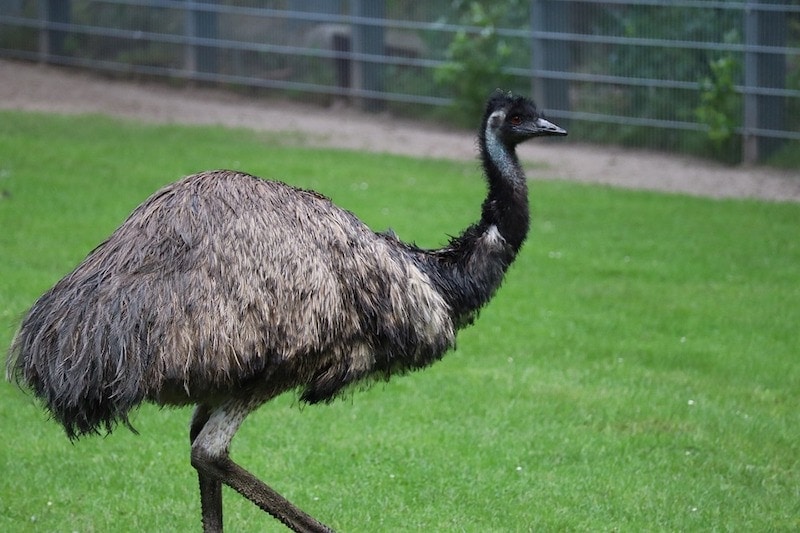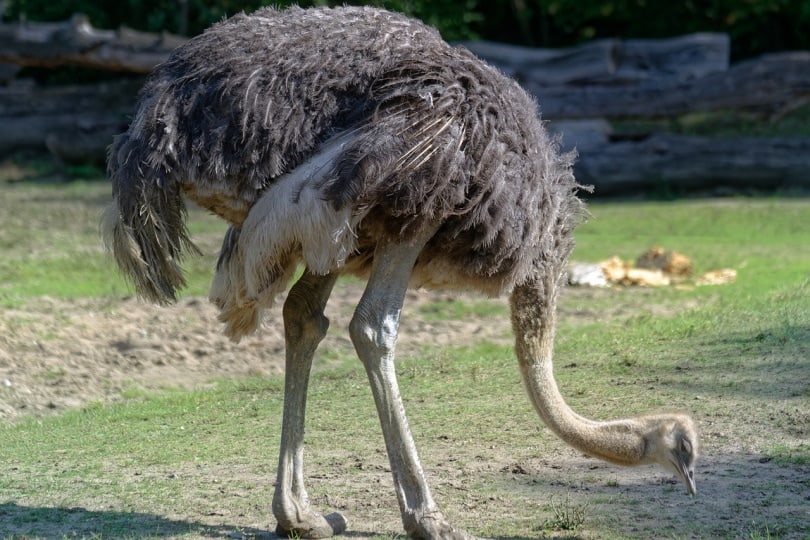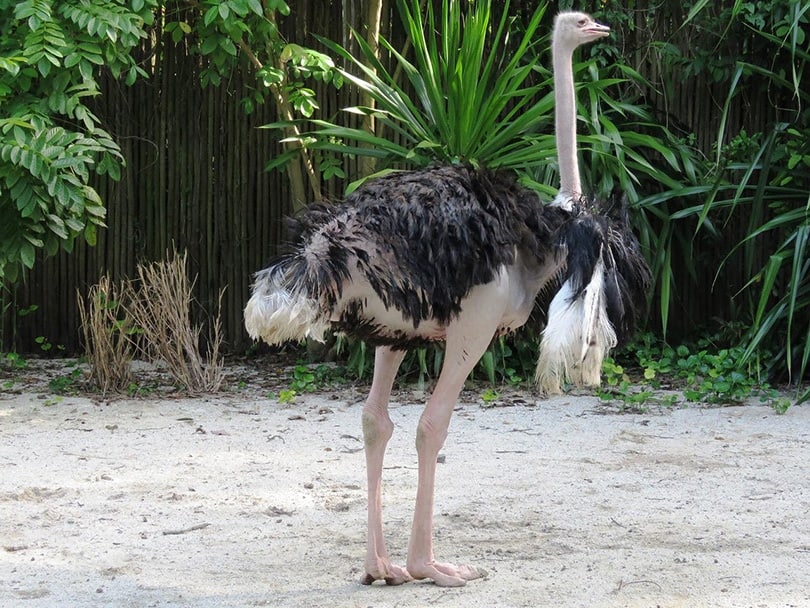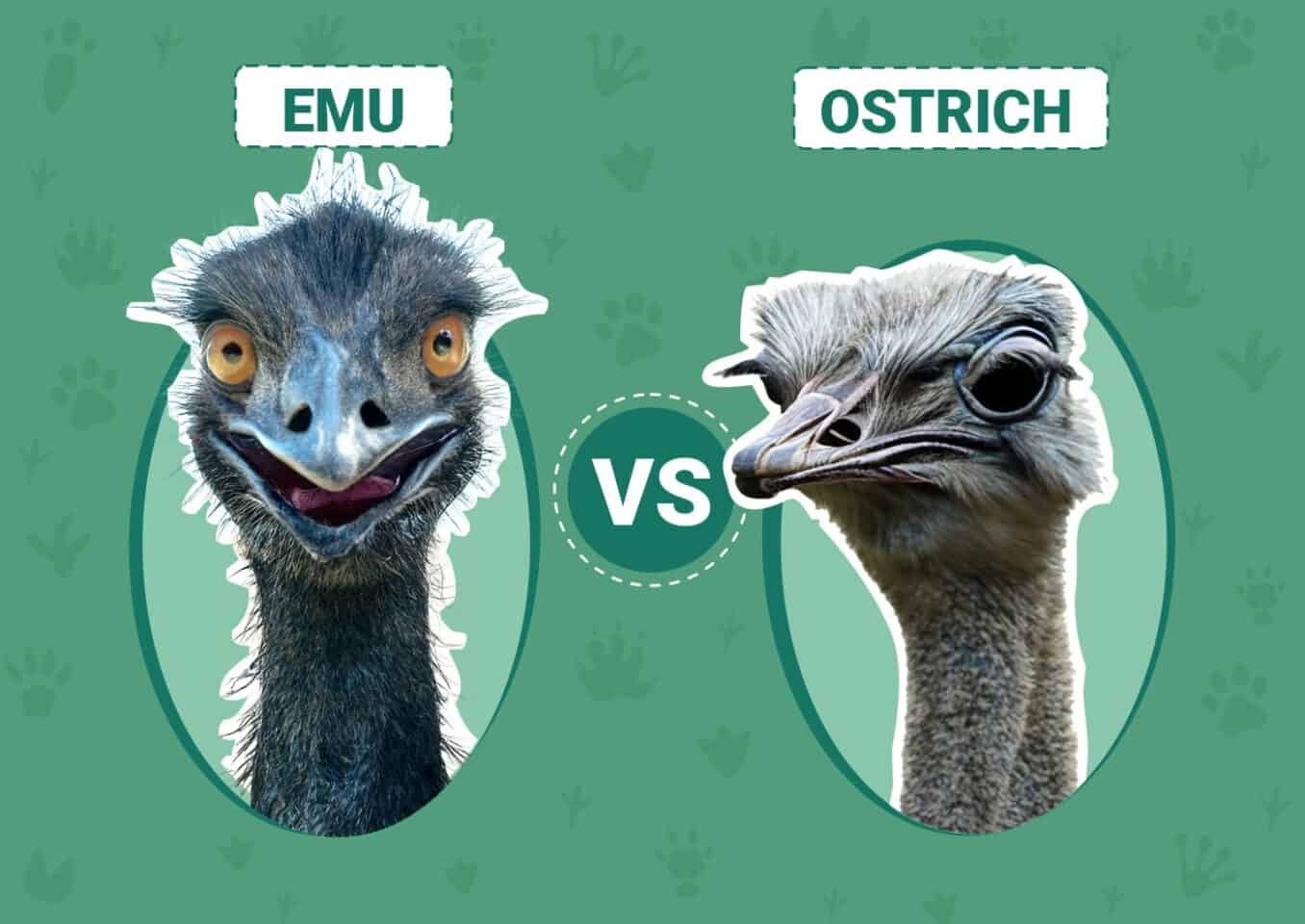Both emus and ostriches are large, flightless birds that belong to the group Ratite. They are among the largest extant flightless birds, so comparisons between them are common. They also look similar, with long, slender necks and legs, large eyes, and cartoonish expressions. They’re also both known for being fast and potentially dangerous to humans.
Aside from these similarities, emus and ostriches are quite different. They have different origins, sizes, coloration, habitats, and behaviors. Explore the differences between the emu and the ostrich to better understand these impressive birds.

Visual Differences

At a Glance
- Origin: Australia
- Size: up to 6.2 ft, 125 lbs
- Lifespan: 10 – 20 years
- Domesticated?: Yes
- Origin: Africa
- Size: up to 9 ft, 300 lbs
- Lifespan: 30 – 40 years
- Domesticated?: Yes

Emu Overview

Emus come from the hot climate in Australia. After the ostrich, the emu is the largest living bird by height. It’s the only living species in the Dromaiidae family but shares the order Casuariiformes with cassowaries and similar birds. Emus are mostly herbivorous but may forage for insects.
Three subspecies of emus are recognized in the northern, southeastern, and southwestern parts of Australia. A fourth subspecies was once found in Tasmania but are now extinct. The conservation status of the emu is of least concern, but the common emu is the only survivor of several that once existed on the island. The rest were likely hunted to extinction.
Characteristics & Appearance
Emus can be up to 6.2 feet tall and 125 pounds. They’re typically dark brown to black in color and produce large, dark green eggs. Despite their size, their wings are smaller than an ostrich and more difficult to see since the wing feathers blend into the body feathers visually. Emus also have three toes on each foot, which help them reach running speeds up to 30 mph.

Uses
Emus have been farmed for meat, eggs, and leather. Though they have relatively small breasts for their size, they have a lot of meat elsewhere on their body and are excellent meat producers. Emus are also raised for oil, which is used in aboriginal therapeutic treatments.

Ostrich Overview

Surprising_Shots, Pixabay
The ostrich originated in Africa and is currently the largest living bird. Ostriches in different populations often showed slight variations in color or size, classifying them as separate species. Now, the ostrich has only two species: the common ostrich (S. camelus) and the Somali ostrich (S. molybdophanes).
Several subspecies of ostriches are recognized, the most common of which is the North African ostrich (S. camelus camelus), which ranges from Morocco to Sudan. Ostriches are the only extant species in the Struthio genus and the only members of the Struthionidae family in the order Struthioniformes, which also contains emus, cassowaries, and kiwis. Like emus, ostriches mainly eat vegetation, but they’re omnivores and will also eat insects or small reptiles.
Characteristics & Appearance
Ostriches may reach heights of 9 feet and may weigh up to 300 pounds. Males are mostly black with white plumes on the wings and tails, which help them stand out from the other feathers. Females are mostly brown. Both sexes have a reddish to bluish neck and head with light down and bare legs. Their large brown eyes have thick, distinctive black lashes.
Ostriches have two toes, which help them reach speeds up to 45 mph—much faster than emus. They may be found individually, in pairs, in small flocks, or in large flocks, depending on the season. When threatened or cornered, the ostrich will kick to defend itself.

Uses
Ostriches are mainly raised for their meat and hide, which provides a soft, fine-grained leather. They may also be raised for eggs. There’s a considerable market for ostrich feathers, which were once used to adorn the helmets of European knights, but this is a byproduct of other farming practices.
Ostriches have been trained under saddle and for sulky racing, but they lack the endurance for racing and aren’t easily trained like other racing animals (horses and dogs). They do adapt well to captivity and can live up to 50 years with the right care.
What Are the Differences Between Emus & Ostriches?
Emus and ostriches have notable differences in their size and looks. The ostrich is the much larger of the two and has two toes, which contribute to its faster running speed. They’re both raised for meat, eggs, and leather, but emus may also be raised for oil. Ostrich farmers will often collect ostrich feathers as an added benefit of farming.
They’re also suited to different environments. Emus are best suited to the climate and terrain in Australia, while ostriches are a desert species from Africa.

Which Is Right for You?
Though similar, the emu and ostrich have considerable differences in size, coloration, origin, and uses. Both animals can thrive with proper care and may be suitable for production farming, but they can be dangerous birds for inexperienced keepers.
Featured Image Credit: top (emu): christels Pixabay / bellow (ostrich): dimitrisvetsikas1969, Pixabay
